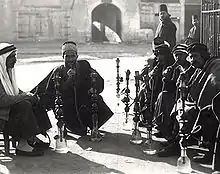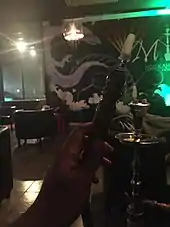Hookah lounge
A hookah lounge (also called a shisha bar or den, especially in Britain and parts of Canada, or a hookah bar) is an establishment where patrons share shisha (flavoured tobacco) from a communal hookah or from one placed at each table or a bar.

In Western countries, shisha parlors are often owned and operated by people from the Arab world or South Asia where use of the hookah is a centuries-old tradition. Many shisha parlors incorporate such elements as Islamic decor and Arabic music or Indian music and have traditional decor, but some are simply bars without the eastern cultural elements.[1]
Characteristics
In the United States and Europe, shisha parlors are most popular in college towns and urban areas and are regarded by some as a novel and chic way to socialize. Certain parlors offer modern hookahs with fruit bowls or other kinds of improvements over smoking hookah at home.[2] Some people of Middle Eastern or South Asian extraction consider them a continuation of their own cultural traditions. However, shisha parlors nowadays often distance themselves from the eastern cultures by offering hookah and alcohol without the cultural elements. These bars differ from other bars only in the fact that they offer hookah.
Usually a disposable mouthpiece is provided for each user for hygienic reasons. When alcohol is not sold, shisha parlors derive revenue from sales of coffee, tea, soft drinks and snack foods.
Some shisha parlors have well-equipped kitchens and are more akin to bistros. In the broadest sense, any restaurant or nightclub can be considered a shisha parlor or club if it offers patrons hookahs, shisha and a comfortable place to smoke. Some offer Middle Eastern cuisine menu items.
In the United States, due to several state tobacco control laws, many shisha bars have made the transition from offering tobacco shisha to herbal shisha, which is tobacco-free and can legally be smoked indoors in areas that have restrictions on tobacco smoking. Although herbal shisha does not contain tobacco or nicotine, when burned it does produce harmful chemicals, including heavy metals and polycyclic aromatic hydrocarbons, which can cause cancer and heart disease. These harmful chemicals are breathed in both by smokers and bystanders.[3]

History
The origins of hookah are controversial, even though most agree that it started either in ancient Persia or the Indian subcontinent.[4]
In Europe
Hookah smoking is common in many European[5] and other countries including:
- Germany – Hookahs are available in many establishments in Germany, particularly in Berlin, Cologne and the Ruhr Area and areas, and it is not only popular amongst Turkish people. The German customs authority recorded a growing trade with illegal and untaxed shisha tobacco in 2017. While previously shisha was smuggled via ports in Rotterdam and Hamburg, a trend was noted where the tobacco was produced in hidden factories in Germany according to René Matschke, the chief of customs in Hamburg.[6]
- Netherlands – Hookahs are now gaining popularity in the Netherlands, particularly in Rotterdam and Amsterdam.
- United Kingdom – In the United Kingdom, hookahs are most commonly found in "shisha bars" run by Lebanese, Pakistani or Egyptian people. Since a 2007 British ban on smoking in public places, Shisha bars have risen from 179 in 2007 to 556 in 2012.
- Spain – Hookah use has grown in popularity in Spain, especially among the young. As a result, many teterías (tea houses) have made hookahs available to patrons.
- Russia – Due to heavy influence from South Caucasus and Central Asia, hookahs have become a widespread recreational practice in large Russian cities, and are now offered in many cafes and restaurants.
- Denmark – Shisha bars have gained popularity in the recent years. Shisha Parlors are present in Aarhus, Odense, and Copenhagen and other cities.
In the United States

In the United States, establishments akin to shisha parlors first opened decades ago in the immigrant quarters of New York City, Chicago, and Los Angeles, California as coffee and tea houses.
Many shisha parlors in the United States have modernistic elements such as glass tables, plasma televisions, and oxygen bars. Most bars in the U.S. require patrons to be at least 21 years of age to smoke shisha and 21 years of age to purchase (exceptions are Utah, Arizona, Alabama, and New Jersey: 19 years of age to smoke; New York and Vermont are 21 years of age). [2][7]
It is not uncommon now to find shisha bars within short distance of college campuses and in the surrounding towns. For private hookah smokers, many Middle Eastern and Mediterranean markets now offer hookah products for sale.
In Asia
- VietNam-Shisha appeared in Vietnam in 2009. This is a very popular trend in Vietnam until now. It is rated as safe and not as dangerous as cigarettes so the number of users increases greatly. At first, shisha was mainly used in Hanoi and Ho Chi Minh City, and now the number of shisha users has appeared in the whole territory of Vietnam.[8]
Smoking bans and exemptions
Many municipalities, especially in North America and Europe have enacted smoking bans in public places. Sometimes, however, businesses can obtain special permits allowing smoking within; these permits are typically available only for shisha bars, cigar bars, tobacconists, and similar establishments where smoking is the focus of activity. They are less frequently available for places in which alcohol or food is served.
In some cases, the ban is against tobacco smoking specifically. When this is the case, a shisha bar may remain in business by replacing traditional, tobacco-based shisha with a tobacco-free mu‘assel.
In order to remain open, many shisha bars cannot sell food or beverages. Approximately 90% of the cities that have put a ban on smoking in public places have exemptions for shisha bars. The cities with these kinds of exemptions, typically, have more dense populations.[9]
Public health concerns
Because shisha bars are exempt from many smoking bans, there is a growing public health concern. Many hookah users do not understand the health risks that come along with the practice. Common beliefs include that shisha is not addictive and that the smoke contains fewer carcinogens. However, hookah smoke contains the same chemicals found in cigarettes and it is not safer because it is smoked as often as are cigarettes. The tobacco is addictive; even if it is filtered with water, the carcinogens are not filtered out.[10] Traditional charcoal-heated hookahs deliver nine to ten times more carbon monoxide than do standard cigarettes.[11] There have been multiple published reports of acute carbon monoxide poisoning caused by narghile (waterpipe tobacco/hookah).[12] It has also been shown that waterpipe tobacco contains 27 known or suspected carcinogens, as well as significant concentrations of toxicants thought to cause dependence, heart disease and lung disease.[13][14][15] For this reason, many cities seek to create tougher restrictions for shisha bars, and some want them shut down altogether.
References
- "East Bay: Aromas, relaxation are the hook in hookah". 20 May 2005. Retrieved 4 October 2018.
- "Hookah Bars Finding a Place in America - Health - RedOrbit". 27 September 2007. Archived from the original on 2007-09-27. Retrieved 4 October 2018.
- Hammal, Fadi; Chappell, Alyssa; Wild, T. Cameron; Kindzierski, Warren; Shihadeh, Alan; Vanderhoek, Amanda; Huynh, Cong Khanh; Plateel, Gregory; Finegan, Barry A. (2015). "'Herbal' but potentially hazardous: an analysis of the constituents and smoke emissions of tobacco-free waterpipe products and the air quality in the cafés where they are served". Tobacco Control. 24 (3): 290–297. doi:10.1136/tobaccocontrol-2013-051169. ISSN 1468-3318. PMID 24128428. S2CID 33155013.
- "article-niche.com". article-niche.com. Retrieved 4 October 2018.
- Jawad, Mohammed (2014-03-18). "Legislation Enforcement of the Waterpipe Tobacco Industry: A Qualitative Analysis of the London Experience". Nicotine & Tobacco Research. 16 (7): 1000–1008. doi:10.1093/ntr/ntu022. ISSN 1469-994X. PMID 24642591.
- Niewerth, A. Dinger, C. Unger und G. (2018-11-29). "Auch Berlin plant härtere Regeln für Shisha-Bars". www.morgenpost.de (in German). Retrieved 2018-12-09.
- "Tobacco 21 Law Takes Effect September 1, 2019 | Division of Liquor Control". liquorcontrol.vermont.gov. Retrieved 2020-01-06.
- "Hút shisha có độc hại như thuốc lá không". shishahome.vn (in Vietnamese). Retrieved March 1, 2019.
- Primack, Brian A.; Hopkins, Maggie; Hallett, Cynthia; Carroll, Mary V.; Zeller, Mitchell; Dachille, Kathleen; Kim, Kevin H.; Fine, Michael J.; Donohue, Julie M. (2012). "US Health Policy Related to Hookah Tobacco Smoking". American Journal of Public Health. 102 (9): e47–e51. doi:10.2105/AJPH.2012.300838. PMC 3482044. PMID 22827447.
- Morris, Daniel S.; Fiala, Steven C.; Pawlak, Rebecca (2012). "Opportunities for Policy Interventions to Reduce Youth Hookah Smoking in the United States". Preventing Chronic Disease. 9: E165. doi:10.5888/pcd9.120082. PMC 3505114. PMID 23153772.
- Rezk-Hanna, Mary; Mosenifar, Zab; Benowitz, Neal L.; Rader, Florian; Rashid, Mohamad; Davoren, Katherine; Moy, Norma B.; Doering, Lynn; Robbins, Wendie; Sarna, Linda; Li, Ning; Chang, L. Cindy; Elashoff, Robert M.; Victor, Ronald G. (2019). "High Carbon Monoxide Levels from Charcoal Combustion Mask Acute Endothelial Dysfunction Induced by Hookah (Waterpipe) Smoking in Young Adults". Circulation. 139 (19): 2215–2224. doi:10.1161/CIRCULATIONAHA.118.037375. PMID 30764644. S2CID 73455348.
- Fauci, Giovanna La; Weiser, Giora; Steiner, Ivan P.; Shavit, Itai (2012). "Carbon monoxide poisoning in narghile (Water pipe) tobacco smokers". Canadian Journal of Emergency Medicine. 14 (1): 57–59. doi:10.2310/8000.2011.110431. PMID 22417961.
- Al Ali, Radwan; Rastam, Samer; Ibrahim, Iman; Bazzi, Asma; Fayad, Sanaa; Shihadeh, Alan L.; Zaatari, Ghazi S.; Maziak, Wasim (2015). "A comparative study of systemic carcinogen exposure in waterpipe smokers, cigarette smokers and non-smokers". Tobacco Control. 24 (2): 125–127. doi:10.1136/tobaccocontrol-2013-051206. PMC 4136964. PMID 23988862.
- Shihadeh, Alan; Schubert, Jens; Klaiany, Joanne; El Sabban, Marwan; Luch, Andreas; Saliba, Najat A. (2015). "Toxicant content, physical properties and biological activity of waterpipe tobacco smoke and its tobacco-free alternatives". Tobacco Control. 24: i22–i30. doi:10.1136/tobaccocontrol-2014-051907. PMC 4345918. PMID 25666550.
- Channick, Robert. "Hookah Lounges Thriving, Three Years after Smoking Ban." Chicago Tribune. N.p. Web.13 Apr. 2011.
Further reading
- "Putting a Crimp in the Hookah" article by Douglas Quenqua in The New York Times May 30, 2011